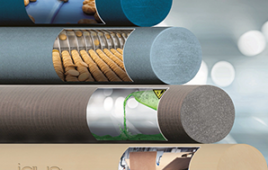It’s important to know the difference between materials when planning operations—both in terms of product outputs as well as in terms of ensuring efficient, long-term machine functionality.
When it comes to the two of the most widely used stainless steels in the world, 304 and 316, selecting the most optimal material can mean longer lasting performance, especially in challenging corrosive environments.
Stainless steel and its anti-corrosion properties
The term “stainless” steel makes it sound like its key property is a resistance to staining, but that’s only part of the picture. The main benefit to using stainless steel is its exceptional resistance to corrosion.
All steels are primarily composed of iron. What makes steel “stainless” is the addition of other alloys—namely chromium. Most stainless steels contain a minimum of 10.5 percent chromium in their mixture. Nickel, titanium, aluminum, copper, nitrogen, phosphorous and selenium are other common alloys.
For 304 and 316 stainless steels, the presence of molybdenum is mainly what makes them different. The additional alloy increases corrosion resistance, especially in high-saline environments where exposure to chlorides is common.
Rust is a type of corrosion involving iron and oxygen in the presence of water. Iron is very susceptible to corrosion, as you’ll eventually see when bare metal surfaces are left in a moist environment for extended amounts of time.
Clean surfaces quickly turn to a red flaky oxide that will eat away at the material, compromising its internal structure. Most metals corrode in their natural environment, which is why they typically require extraction from raw ore. Gold, silver, platinum and copper are some of the few metals that can be found in pure form in a natural environment.
Chromium is a key alloy in all stainless steels for a reason. Far from being anti-corrosive itself, chromium actually reacts quickly with oxygen environments, just like other metals.
The difference is that chromium oxide is very hard and dense—and non-reactive. It essentially forms a protective barrier that isolates internal stainless steel from oxidizing environments.
Because the barrier is quick to form, it is also self-replenishing. If scratched or removed, it is quick to renew, meaning the overall structure of the material almost always has a strong surface defense.
The chromium oxide that forms is so thin that it’s virtually transparent. Because it’s non-reactive, it won’t transfer to other surfaces or substances it comes into contact with. Once oxidized, stainless steel corrodes at a very slow rate of about 0.002 inches per year—meaning your parts will last an exceptionally long time, even within environments that would be corrosive for standard steel.
304 stainless steel
304 stainless steel contains between 16 and 24 percent chromium and up to 35 percent nickel. It also contains small amounts of carbon and manganese. 304 stainless steel is the most common form of stainless steel used around the world—specifically a form called 18-8, or 18/8, stainless steel, which contains 18 percent chromium and 8 percent nickel (as the name implies).
304 stainless steel is an austenitic steel, as is defined by its molecule structure. Austenitic stainless steel offers a solid balance of strength and workability across a wide temperature range, making it useful for many applications.
304 stainless steel is often used for kitchen and food applications, specifically beer brewing, milk processing and wine making. It is also common in architectural designs, chemical containers, water filtration screens, threaded fasteners and springs.
Where 304 stainless steel is vulnerable, however, is in its susceptibility to corrosion from chloride solutions. Chloride ions can create pitting or crevassing, which are basically localized areas of corrosion. These compromised areas can spread beneath chromium oxide barriers to compromise internal materials.
High saline environments such as outdoor coastal areas or cold, icy areas that receive regular exposure to de-icing salts may be unsuitable for 304 stainless steels. Manufacturing environments or other commercial applications that involve chemicals—specifically chloride solutions—may also be problematic for products and equipment.
316 stainless steel
316 stainless steel is the second-most common form of stainless steel used in the world. It is characterized by the addition of molybdenum—about 2 to 3 percent of total composition—which ensures a higher degree or corrosion resistance.
Other 300-series stainless steels can contain up to 7 percent molybdenum. It is especially useful where 304 stainless steels fail—i.e. where chlorides and/or other industrial chemicals are common.
For outdoor applications, 316 stainless steel is ideal for high moisture environments with regular salt exposure. Often referred to as “marine-grade” steel, 316 stainless steel is used often for ocean waterfront applications. In addition to applications typical for 304 stainless steel, 316 grades are common in laboratories, coastal buildings and architecture and boat fittings.
It’s also a useful material for manufacturing environments where exposure to corrosive chemical solvents is common. Medical applications are also widespread, as 316 stainless steel is highly-unreactive, which helps minimize risk of contamination.
Balancing performance and cost
Knowing the difference between material grades can not only mean the difference in long-term performance, it can also mean avoiding spending more than you have to. Higher grade products or materials may offer features beyond what you’re looking for.
Avoiding material corrosion and wear can help save on costs associated with ongoing maintenance—not to mention the risk of failure and halted operations—but spending more than you need to can lead to an inflated budget.
Filed Under: Materials • advanced




